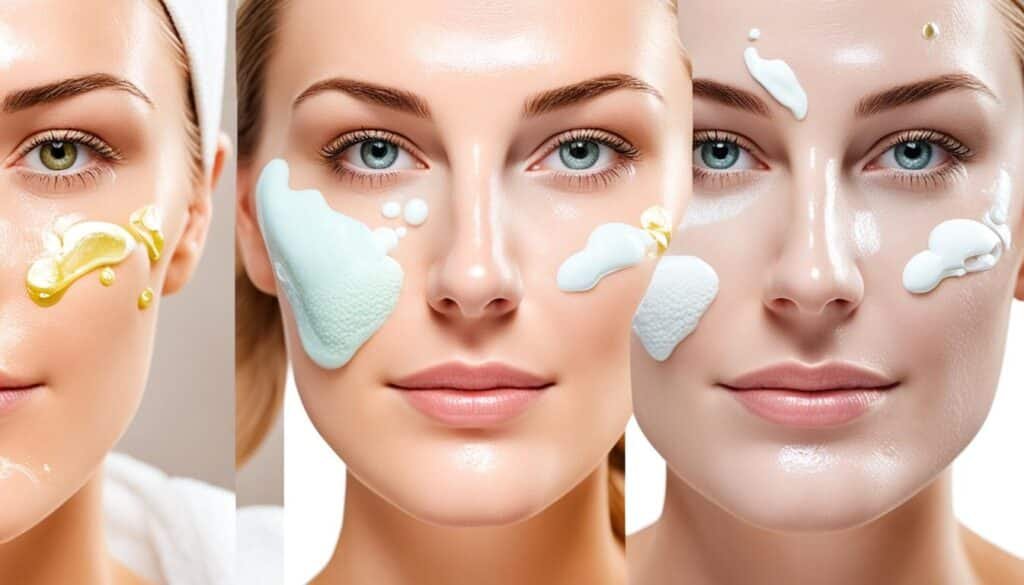Skin Care Routine For Oily Skin of the most common skin concerns. It presents some unique challenges, like a shiny complexion and acne breakouts. The good news is that with the right skin care routine and products, these issues can be less of a problem. The ultimate skin care routine for oily skin includes cleansing, toning, treating, moisturizing, and protecting with sunscreen. Following this routine can help control shine, minimize pores, and achieve a balanced, glowing complexion.
Key Takeaways: Skin Care Routine For Oily Skin
- Oily skin is a common skin type that can lead to shine and breakouts.
- A dedicated skincare routine for oily skin includes cleansing, toning, treating, moisturizing, and protecting.
- Cleansers with salicylic acid can help control oil and unclog pores.
- Toners with exfoliating acids remove excess oil and impurities.
- Targeted treatments like benzoyl peroxide and retinol can address acne and clogged pores.
- Moisturizing is important, even for oily skin, but use oil-free, non-comedogenic formulas.
- Completing a morning and evening routine can help maintain a balanced, shine-free complexion.
Understanding Oily Skin
Oily skin is one of the most common skin concerns, presenting unique challenges such as a shiny complexion and acne breakouts. This oily skin condition is primarily due to the size and activity of the oil glands attached to the hair follicles. To effectively address oily skin, it’s essential to understand the causes and signs of this skin type.
What Causes Oily Skin?
Oily skin is usually caused by the overproduction of sebum, the natural oil produced by the skin’s sebaceous glands. This excess oil can lead to a glossy, shiny appearance and can also contribute to the development of acne. Factors that can influence the skin’s oil production include genetics, hormonal changes, stress, and environmental factors.
Signs of Oily Skin
People with oily skin often experience a number of telltale signs, including a shiny, oily complexion, enlarged pores, and a tendency for frequent breakouts. The skin may also have an uneven skin tone and can often feel greasy or slick to the touch. Proper skin care and targeted treatments can help those with oily skin achieve a clear, healthy-looking skin.
Importance of a Dedicated Routine

To help take the guesswork out of how to care for an oily skin complexion, experts recommend developing a dedicated daily skin care routine. Following a simple four-step routine in the morning and evening can help keep oily skin healthy, clear, and shine-free. This routine includes cleansing, toning, treating, and moisturizing the skin.
Having a skincare routine tailored to your skin type is crucial for managing acne and controlling oily skin. By incorporating the right skin care products and techniques into your daily routine, you can help keep your skin balanced, calm, and glowing.
Whether your skin tends to be oily, combination, or sensitive, a dedicated skincare routine can make a significant difference in the health and appearance of your skin. By following a consistent routine, you can address your specific skin concerns and achieve the glowing skin you desire.
| Benefit | Description |
|---|---|
| Balanced Complexion | A dedicated skin care routine can help control oily skin and minimize the appearance of shine, leading to a more even skin tone. |
| Targeted Treatments | By incorporating targeted treatments like salicylic acid and retinol into your routine, you can effectively address acne and blemishes. |
| Healthy Skin Barrier | A consistent skincare routine can help strengthen the skin barrier, preventing dryness and maintaining the skin’s natural moisture levels. |
| Glowing Complexion | With the right skin care products and techniques, a dedicated routine can help improve the overall health and appearance of your skin, leaving it calm, clear, and glowing. |
By investing in a skincare routine tailored to your unique skin type and concerns, you can take control of your oily skin and achieve the healthy, radiant complexion you desire.
Step 1: Cleanse Effectively

Cleansing is the most important step in any skin care routine, especially for those with oily skin. Experts recommend washing your face morning and night with an exfoliating cleanser to remove dirt, sebum, and impurities without stripping the skin of its natural oils. Look for cleansers containing salicylic acid, which can help unclog pores and prevent future breakouts.
Best Cleansers for Oily Skin
When selecting a cleanser for oily skin, opt for formulas that contain salicylic acid or other exfoliating ingredients to help slough off dead skin cells and prevent clogged pores. Avoid harsh, drying cleansers, which can actually cause the skin to produce more oil in response. Instead, choose a gentle, non-comedogenic cleanser that won’t strip the skin of its essential moisture.
Cleansing Technique
For best results, massage the cleanser into your skin for a few seconds using gentle, circular motions. This helps ensure the active ingredients can effectively penetrate and cleanse the pores. Rinse thoroughly with lukewarm water, and pat your skin dry without rubbing. Completing this step morning and night can help keep your oily skin looking and feeling its best.
Step 2: Use a Toner

After cleansing, experts recommend following up with an exfoliating toner to remove any last traces of dirt, oil, or makeup. Toners containing salicylic acid, glycolic acid, or lactic acid can help unclog pores, control shine, and leave the skin feeling refreshed. This step is crucial for preventing clogged pores and breakouts in those with oily skin.
Benefits of Toners for Oily Skin
Toners can provide a number of benefits for oily skin types. They help to balance the skin’s pH, remove any last traces of impurities, and prepare the skin to better absorb the subsequent skincare products. Additionally, toners with active ingredients like salicylic acid can help control shine, minimize the appearance of pores, and calm inflammation associated with acne-prone skin.
Recommended Toners
When selecting a toner for oily skin, look for formulas containing alpha hydroxy acids (AHAs) like glycolic acid or lactic acid, or beta hydroxy acids (BHAs) like salicylic acid. These exfoliating ingredients can slough off dead skin cells, unclog pores, and mattify the complexion. Avoid toners with alcohol or fragrance, as these can further strip the skin and disrupt the skin barrier. Opt for soothing, hydrating formulas that will calm the skin without excessive drying.
Step 3: Treat Acne and Blemishes

For those with oily, acne-prone skin, the next step is to target any existing blemishes or trouble areas. Incorporating targeted treatments can effectively address the specific concerns of an oily skin type and help achieve a clear, glowing complexion.
Benzoyl Peroxide for Acne
Benzoyl peroxide is a powerful acne-fighting ingredient that can be used in the morning to help prevent new breakouts. This ingredient works by killing acne-causing bacteria and drying out existing pimples. Introduce a benzoyl peroxide product slowly and apply it only to affected areas to avoid excessive drying or irritation.
Retinol for Pore Unclogging
Retinol, a form of vitamin A, should be applied in the evening to unclog pores and promote skin cell turnover. This potent ingredient can help minimize the appearance of enlarged pores and blemishes, leaving the skin with a smoother, more even texture. Start with a low concentration of retinol and gradually increase frequency to avoid excessive dryness or peeling.
Step 4: Moisturize Wisely
Moisturizing is an important step that is often overlooked by those with oily skin. However, experts warn that avoiding moisturizer can actually cause the skin to produce more oil. The key is to use a lightweight, non-comedogenic moisturizer that won’t clog pores. Look for water-based, oil-free formulas that are designed for acne-prone or oily complexions.
Lightweight, Non-Comedogenic Moisturizers
When it comes to moisturizers for oily skin, it’s crucial to choose products that are lightweight and won’t contribute to clogged pores. Avoid heavy, creamy formulas and instead opt for water-based, oil-free moisturizers that are labeled as “non-comedogenic.” These types of moisturizers are specifically formulated to hydrate the skin without overwhelming it with excess oils or heavy emollients. This helps maintain the skin’s natural balance and prevents the overproduction of sebum that can lead to shiny, acne-prone skin.
Remember, even if your skin is on the oily side, it still needs adequate moisture to stay healthy and glowing. By incorporating a lightweight, non-comedogenic moisturizer into your daily routine, you can hydrate your skin without clogging your pores or triggering breakouts. This step helps calm the skin, improve its overall health, and deliver a radiant, even-toned complexion.
Also Read: Skin Care For Oily Skin: The Ultimate Guide
Conclusion
Crafting the best skin care routine for oily skin involves a careful balance of cleansing, exfoliating, and moisturizing to manage oil production and maintain a healthy complexion. Experts recommend starting with a gentle, foaming cleanser to remove excess oil and impurities without stripping the skin of its natural moisture. Incorporating a salicylic acid or glycolic acid exfoliant can help to keep pores clear and reduce the occurrence of acne. A lightweight, oil-free moisturizer is crucial to keep the skin hydrated without adding extra grease.
Additionally, using non-comedogenic products ensures that the skin remains breathable and free from clogged pores. Sunscreen is a must, even for oily skin, to protect against UV damage; opt for a mattifying formula to avoid a shiny finish. Treatments with ingredients like niacinamide and retinoids can help regulate oil production and improve skin texture over time.
Consistency is key, and it’s important to adapt your routine as your skin’s needs change. By following these expert tips, individuals with oily skin can achieve a balanced, healthy complexion while minimizing the risk of breakouts and excess shine. Regular consultation with a dermatologist can also provide personalized advice and adjustments to ensure optimal skin health.
FAQs
Q: What is the best skin care routine for oily skin?
A: A good skin care routine for oily skin involves using products specifically formulated for oily skin types, including cleansers, toners, moisturizers, and sunscreens that are oil-free and non-comedogenic.
Q: What are some recommended products for oily skin?
A: Some recommended products for oily skin include cleansers containing salicylic acid, oil-free moisturizers, mattifying primers, and gel-based sunscreens.
Q: What ingredients are beneficial for oily skin?
A: Ingredients like salicylic acid, niacinamide, hyaluronic acid, and witch hazel can be beneficial for oily skin as they help control excess oil production and minimize pores.
Q: What are some tips for managing oily skin?
A: Some tips for managing oily skin include washing your face twice a day, using oil-free and non-comedogenic products, avoiding heavy creams, exfoliating regularly, and staying hydrated.
Q: What causes oily skin?
A: Oily skin can be caused by genetics, hormonal factors, environmental factors, overwashing or using harsh products that strip the skin of its natural oils.
Q: How can I build an effective skincare routine for oily skin?
A: To build an effective skincare routine for oily skin, start with a gentle cleanser, followed by a toner, lightweight moisturizer, and sunscreen during the day. Incorporate exfoliation and treatments like clay masks or serums as needed.
Q: Is salicylic acid suitable for oily skin?
A: Yes, salicylic acid is a great ingredient for oily skin as it helps to unclog pores, exfoliate the skin, and reduce excess oil production, making it an effective choice for managing oily skin.




